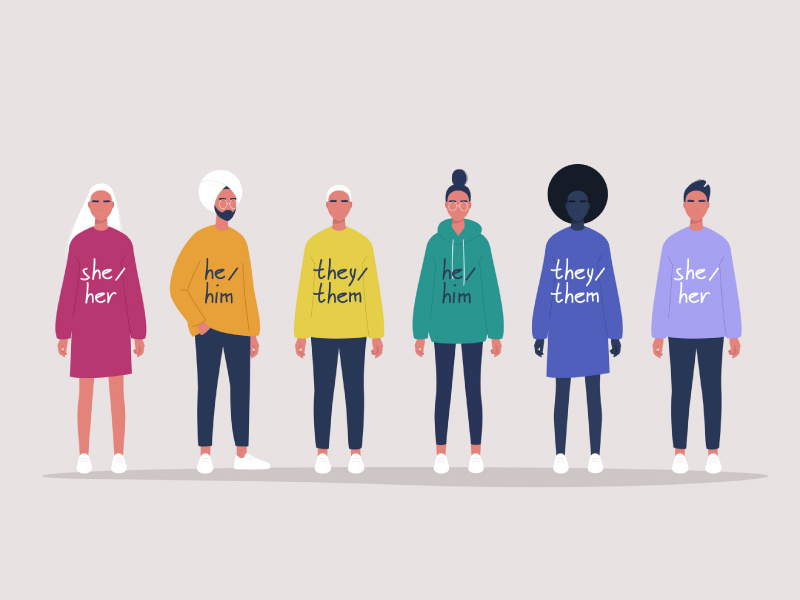
A very private aspect of your life is your gender identity. Generally, the gender assigned at birth becomes the identity of the child and is carried into adolescence and youth. But what if one is not able to identify with the gender assigned at birth and feels like it is continuously changing?
Fret not, there is nothing wrong with being different or feeling different. Just like the LGBTQ community, there are people who identify themselves as gender fluid and is completely normal to feel what you are feeling at present.
Gender Fluidity Definition
Gender fluidity can be understood by grasping the literal meaning of the two terms. A gender-fluid person is flexible with respect to the gender with which they identify themselves. At some times and situations, they may feel more feminine, and on some other days, they feel more masculine
A child tends to identify their gender at the early age of 2 or 3 years when they get to know the societal norms of being feminine or masculine and the way a girl or boy should be presenting themselves. Gender identity develops at this time and is carried out well into youth and beyond, while for some, it changes over a period.
It is fairly common and has been in existence for a long time, and just because it has been under wraps doesn’t mean your feeling are alien or unimportant or a sign of having a mental illness.
Gender Fluidity in History
With more and more celebrities coming out as gender fluid or non-binary, the conversations around gender fluidity have slowly started trickling into mainstream conversations. Although our parents might feel that this millennial 21st-century generation is creating new ideas, the concept has been studied since the 1800s.
There are examples of:
- Ancient Egyptians got gender-swapped to attain an afterlife
- Depiction of the third gender in ancient Italian art and
- The most popular Indian transgender people are thought to have both masculine and feminine characteristics and have been revered for a thousand years.
The concept has existed since ancient times, yet societal norms have significantly influenced it. Expectations for men and women to adhere to specific behaviors have led to the marginalization of those who deviate from these norms.
For millennials like you, who are trying to come out and explain it to your parents, it could be a stressful and daunting task. Fear of rejection and ridicule and causing shock and trauma to parents could be a deterring factor. It is important to explain your feelings organically and maybe take professional help to help your family understand your predicament.
How to Explain Gender Fluidity to Parents?
Usually, when a child comes out to their parents as gender fluid, thousands of emotions run through their minds. They need to treat the child with love, care, and compassion and honor the trust that the child has placed in them.
It is common for children to exhibit behaviors, like boys playing with dolls, but these do not imply gender fluidity. But after attaining puberty, if your child shows persistent and consistent signs of gender identity that do not match their gender assigned at birth, then it’s pertinent that they stick to it.
Although parents of gender-fluid children have an inkling of their fluidity based on their behaviors, they should adopt a wait-and-watch approach. Here are some common queries from children.
FAQs on Gender Fluidity
Are Gender Fluidity and Sexuality Related?
A person’s inner feelings and exhibited characteristics define their gender, while our physical, mental, and emotional aspects determine our attraction—this is our sexuality. It’s crucial to differentiate Gender Fluidity from sexual orientation, avoiding confusion with a child’s identification as gay or lesbian.
Can I read books about Gender Fluidity?
If you wish to learn more about Gender fluidity and be at peace with your emotions, there are various resources available on the net.
- Stone Butch Blues by Leslie Feinberg explores the fading lines between masculinity and femininity.
- George by Alex Bino explores a child’s struggle with gender identity
- Lizard Radio by Pat Schmatz explores gender fluidity through sci-fi themes.
Is Gender Fluidity in Fashion?
Gender Fluidity existed in fashion in the early 18th century, as seen in the pictures of the past. But slowly, the trends changed, and clothes were more gender specific. In the year 2022, gender-fluid clothes became a trend, and more and more fashion brands included them. One must realize that for a section of society, gender fluidity is not just a trend but a reality of life.
How Gen Z and Gender fluidity related?
Gen Z’s openness about their gender identity and sexual orientation has sparked wider discussions on Gender Fluidity. In 2019, the Phluid Project reported that 56% of Gen Z individuals were actively exploring clothing options beyond their assigned gender categories.
Conclusion
A good move is to confide in your parents or your therapist and come to terms with your feelings. It helps you in the myths of gender fluidity being the same as being gay or lesbian or having a mental illness. The times have changed and a full-fledged conversation is what you need with your loved ones and a therapist. The best route is to have full information about your feelings and lead a peaceful and happy life with no nagging secrets in the depth of your heart.










